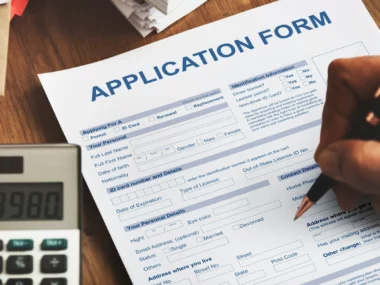If you want to go to college or graduate school, you may need some money to pay for your education and living expenses. A student loan can help you afford these costs and achieve your academic goals.
But how do you apply for a student loan? What are the different kinds of student loans that you can get? What are the requirements and steps that you need to follow?
In this guide, we will explain these questions and more. We will cover the following topics:
- How to apply for a student loan without a co-signer
- How to apply for a college loan
- How to apply for a federal student loan
- How long does it take to apply for a student loan
By the end of this guide, you will have a better idea of how to apply for a student loan and what options are best for you.
How To Apply For A Student Loan Without A Co-Signer
A co-signer is someone who agrees to help you pay back your student loan if you can’t do it yourself. Having a co-signer can make it easier for you to get approved for a student loan, especially if you have a low credit score or no credit history. However, finding a co-signer can be hard or impossible for some students.
If you don’t have a co-signer, don’t worry. You can still apply for a student loan without one. Here’s how:
- Start with federal student loans first. Fill out the Free Application for Federal Student Aid, also known as the FAFSA , to get access to federal loans, grants and scholarships. Most federal student loans don’t require a co-signer or a credit check, except for PLUS loans. Federal student loans also have lower interest rates and more flexible repayment options than private loans.
- Look for private student loans without a co-signer. If you need more money than what federal aid can offer, you can look for private student loans from banks, credit unions, or online lenders. However, private student loans without a co-signer are harder to qualify for and usually have higher interest rates and fees than federal loans. You will need to have a good credit score, a steady income, and a low debt-to-income ratio (DTI) to get approved.
- Compare offers from different lenders. Before you choose a private student loan without a co-signer, it’s important to shop around and compare offers from different lenders. You can use online tools like Credible or NerdWallet to compare interest rates, fees, repayment terms, and other features of various loans.
How to apply for a college loan
A college loan is any type of student loan that is used to pay for college-related expenses, such as tuition, fees, books, room and board, transportation, and personal expenses. There are two main types of college loans: federal and private.
Federal college loans are loans that are offered by the U.S. Department of Education through various programs, such as Direct Subsidized Loans
To apply for a college loan, you will need to follow these steps:
- Fill out the FAFSA. The FAFSA is the application form for federal student aid, including federal college loans. You will need to provide information about your personal and financial situation, as well as your school of choice. You will also need to create a Federal Student Aid ID (FSA ID) to sign and submit the form online. You should fill out the FAFSA as soon as possible after October 1 of each year, as some types of aid are awarded on a first-come, first-served basis.
- Review your financial aid offer. After you submit the FAFSA, you will receive a Student Aid Report (SAR) that summarizes your information and eligibility for federal aid. You will also receive a financial aid offer from each school that you listed on the FAFSA. The financial aid offer will show you how much and what types of aid you can get from each school, including grants, scholarships, work-study, and federal college loans.
- Accept or decline your federal college loans. If your financial aid offer includes federal college loans, you can choose to accept or decline them. You can also accept a partial amount of the loan if you don’t need the full amount. To accept or decline your federal college loans, you will need to follow the instructions from your school’s financial aid office. You may need to sign a promissory note, which is a legal document that states your agreement to repay the loan.
- Look for private college loans if needed. If your federal aid is not enough to cover your college costs, you can look for private college loans from various lenders. You will need to meet the lender’s credit and income requirements or have a co-signer who does. You will also need to compare offers from different lenders and choose the best loan for your situation. You will need to sign a promissory note and other documents to finalize the loan.
How To Apply For A Federal Student Loan
- Fill out the FAFSA. The FAFSA is the application form for federal student aid, including federal student loans. You will need to provide information about your personal and financial situation, as well as your school of choice. You will also need to create a Federal Student Aid ID (FSA ID) to sign and submit the form online. You should fill out the FAFSA as soon as possible after October 1 of each year, as some types of aid are awarded on a first-come, first-served basis.
- Review your financial aid offer. After you submit the FAFSA, you will receive a Student Aid Report (SAR) that summarizes your information and eligibility for federal aid. You will also receive a financial aid offer from each school that you listed on the FAFSA. The financial aid offer will show you how much and what types of aid you can get from each school, including grants, scholarships, work-study, and federal student loans.
- Accept or decline your federal student loans. If your financial aid offer includes federal student loans, you can choose to accept or decline them. You can also accept a partial amount of the loan if you don’t need the full amount. To accept or decline your federal student loans, you will need to follow the instructions from your school’s financial aid office. You may need to sign a promissory note, which is a legal document that states your agreement to repay the loan.
- Complete entrance counseling and exit counseling. If you are a first-time borrower of federal student loans, you will need to complete entrance counseling before receiving your loan funds. Entrance counseling is an online session that explains your rights and responsibilities as a borrower, as well as the terms and conditions of your loan. You will also need to complete exit counseling before leaving school or dropping below half-time enrollment. Exit counseling is an online session that reviews your repayment options,
How long does it take to apply for a student loan
The time it takes to apply for a student loan depends on several factors such as:
– The type of loan: Federal or private
– The lender: Bank, Credit union or online lender
– The school: Public or private
– The borrower: Credit score, I income and debt
For federal student loans, it can take anywhere from a few days up to a few weeks depending on when you fill out FAFSA, when you review the financial aid offer, when you accept or decline loans , when you sign the promissory note, when you complete entrance counselling when your school disburses funds.
For private student loans, it can take anywhere from a few minutes up to a few weeks depending on your credit score, income and debt, when you apply online or by phone when you get prequalified or pre-approved when you compare offers from different lenders when you choose best loan, when you sign promissory note and other documents, when your school certifies loan.
In summary, it can take anywhere from a few minutes up to a few months depending on the type of loan, lender, school, and borrower. To speed up the process and increase your chances of getting approved, you should:
• Fill out FAFSAas soon as possible after October 1of each year
• Review financial aid offers and acceptor decline loans promptly
• Sign promissory note and complete entrance and exit counselling
• Apply for private student loans only if you need additional funding
• Compare offers from multiple lenders and choose the best loan for your situation
• Provide accurate and complete information and documentation to your lender and school
• Check your loan status and follow-up with your lender and school if needed
Securing a student loan without a cosigner or with a cosigner requires careful planning and research. Explore federal student loan options through the FAFSA, and if needed, consider private student loans from reputable lenders.
Remember to borrow responsibly, keep track of your loan balance, and prepare for repayment after graduation. By taking these steps, you can navigate the process of obtaining a student loan and focus on your academic pursuits without unnecessary financial stress.






